Find a book

A Book a Month
We can send a book a month for six or twelve months - the perfect gift. More »

Café Music
Listen to our album of Café Music while browsing the site. More »

A parallel in pictures to the world of Persephone Books.
To subscribe, enter your email address below and click 'Subscribe'.
6 September 2019
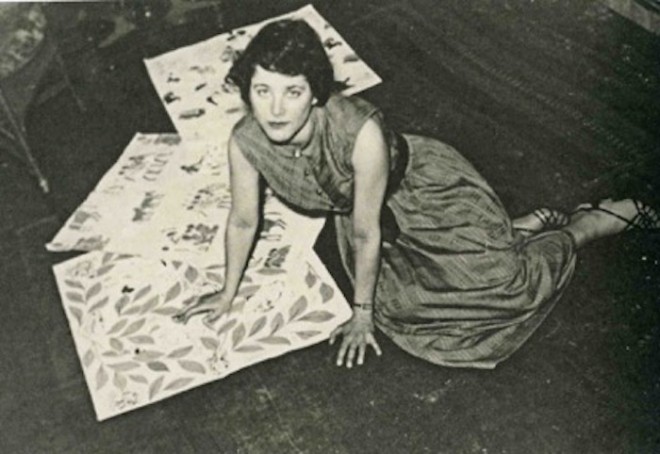
And finally, here is Judith Kerr in 1948 with three of her fabric designs.
5 September 2019
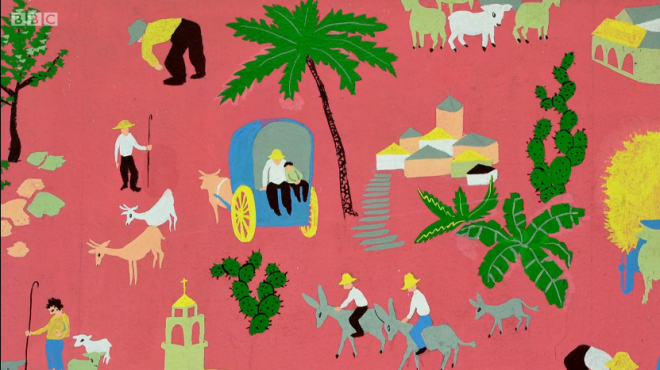
One of the loyal readers of the Post has written to say it has been too brief about Judith Kerr! We adore her of course and could write reams. But the political situation has been SO preoccupying this week. Could the tide have turned? Could Boris Johnson have overreached himself? Isn’t it absolutely shocking about Nicholas Soames and Ken Clarke and Dominic Grieve? Hasn’t Jess Phillips been wonderful? And the backbenchers – someone called Helen Jones was absolutely brilliant. So apologies to all the Judith Kerr fans, of whom we at Persephone Books are at the forefront, it looks as though we aren’t interested in her. We are, we are. But here (with no comment except isn’t it beautiful? What a pink!) is another 1948 textile design.
4th September
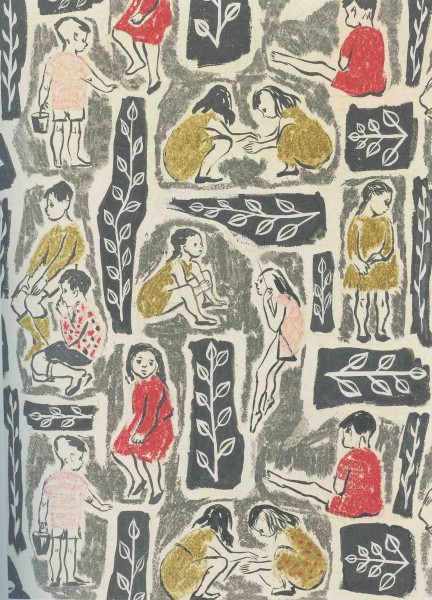
Another 1948 textile design, again taken from a new book about Judith Kerr by Joanna Carey. This is Jeux d’enfants.
3rd September 2019
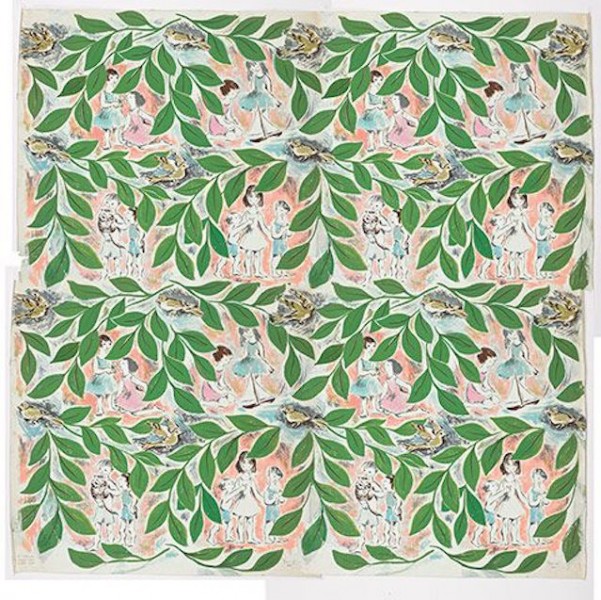
So as is well known from When Hitler Stole Pink Rabbit, Judith Kerr’s family were hounded out of Germany and settled in England. She went to art school (to Central) and in the late 1940s did some textile designs. This is Spring, dated 1948.
2nd September 2019
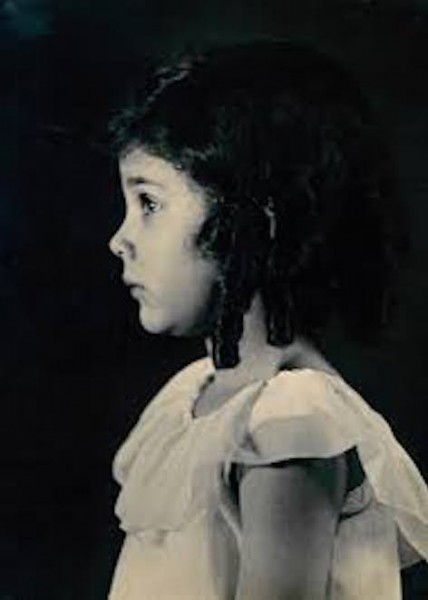
This week on the Post we celebrate Judith Kerr (1923-2019) who, as well as being the celebrated author of books like The Tiger who Came to Tea, was also – a textile designer. First of all, here she is as a very young child, in a photograph that can be seen at the exhibition of the work of Gerty Simon at the Wiener Library. (Gerty Simon’s work will be celebrated on the Post next week.)
30 August 2019
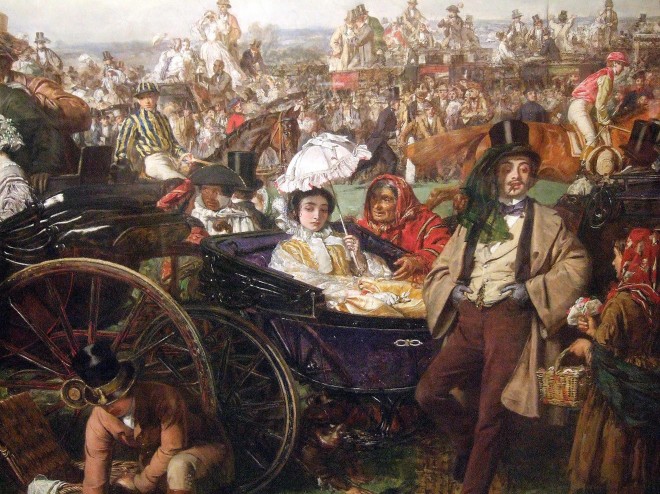
‘Despite a remarkable feat of organisation, The Derby Day remains fairly static, and the figures are more interesting when examined individually. There are three main incidents taking place in the picture. On the far left [Wednesday’s Post] a group of men in top hats focus on the thimble-rigger with his table, inviting the audience to participate in the game. The man taking a note from his pocket is the trickster’s accomplice. He is tempting the rustic-looking man in a smock, whose wife is trying to restrain him. On the right of this group [yesterday’s Post] another man, with his hands in his pockets, has had his gold watch stolen by the man behind. In the centre of the picture we see the acrobat and his son, who looks longingly over at a sumptuous picnic being laid out by a footman. Behind them are carriages filled with race-goers, including a courtesan on the far right [today’s Post] who is the kept mistress of the foppish-looking character leaning against the carriage. (The courtesan is balanced on the far left of the picture by the woman in a dark riding habit, one of a number of high-class prostitutes who daily paraded on horseback in Hyde Park)’ (here at Costume Cocktail). The irony is that Frith’s Derby Day was the kind of painting that bourgeois families liked to hang in reproduction over the dining room sideboard. But actually, as this commentator points out, the ‘short stories’ it contains were quite louche and if anyone bothered to look carefully at what was going on, the action and atmosphere was pretty disreputable.
29 August 2019
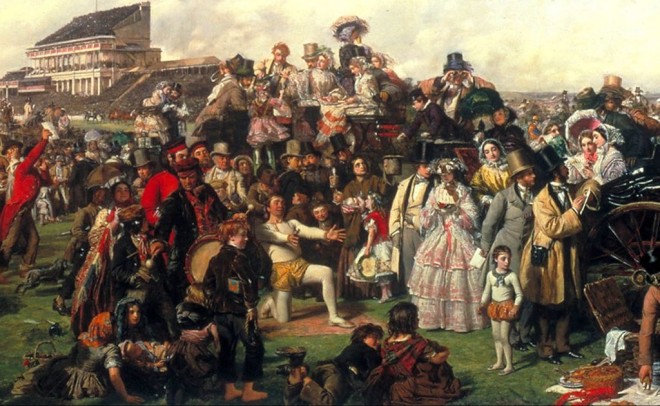
‘In the centre of the picture is a boy selling cigars from the box under his arm. In his hand is a piece of smouldering tarred rope for him to give the customer a light. To the right of this boy is an acrobat, encouraging his son to leap into his arms. The son is not paying attention but staring at the luxurious picnic being unpacked from a wicker hamper by a rich family’s footman. There is a large pie and a whole lobster, among other delicacies. Straw packaging from the hamper and a large lump of ice are also on the ground. Frith found the acrobat and his son in a pantomime at Drury Lane but they were not able to sit still for long periods, so Frith bought their costumes from them for professional artists’ models to wear. A preliminary rough sketch of the acrobat’s pose is in the British Museum’ (taken from Epsom and Ewell History here).
